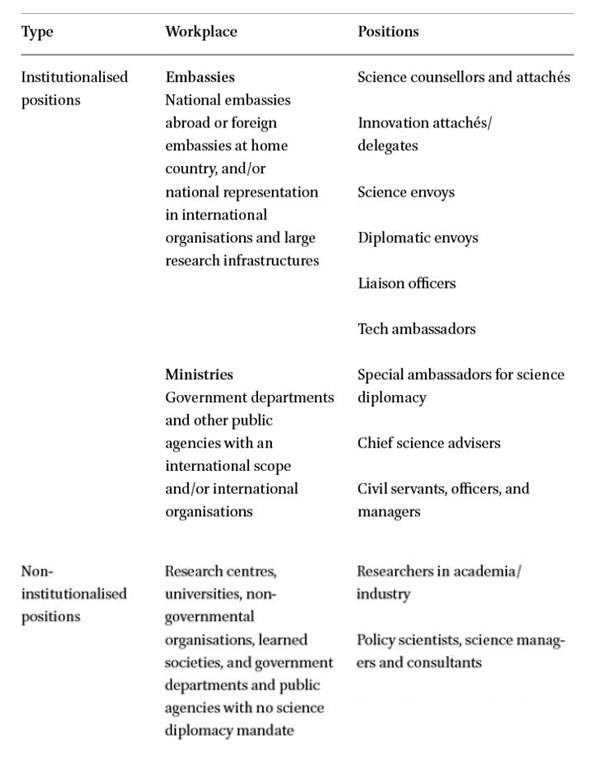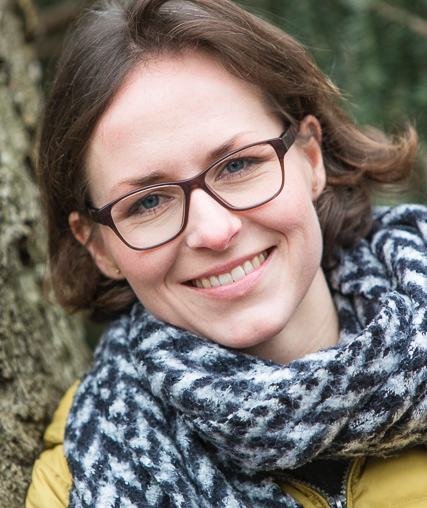2.4 What Kind of Science Diplomats Are There?
This lesson aims to provide real examples of science diplomats, their responsibilities and required set of skills (i.e.: diplomats, science attaché, chief science adviser, and others).
Science diplomacy takes place in a variety of contexts. The formalised science diplomacy positions at embassy-level (e.g. by attachés and counsellors) usually have a well-defined profile. However, there is considerable variation between countries and their institutions in how individuals get recruited to become science diplomats, how their career paths are and can be shaped and what political relevance is attributed to their specific subject area etc. (Degelsegger-Martínez et al. 2018; Melchor 2020).
We can divide the types of science diplomats in the following two main categories:
- Institutionalised positions: science attachés, science advisors, research councils’ and public research organisations’ representatives deployed abroad, etc. who either have a formal science diplomacy mandate and/or who actively bring science policy and foreign policy together in their daily job.
These profiles will be covered in topics 2.4.1 Diplomats, 2.4.2 Chief science advisers, and 2.4.3 Science counsellors, attachés, advisers and envoys in embassies. - Non-institutionalised positions: scientists; managers and administrators of agencies or research organisations with no formal science diplomacy mandate; civil society representatives (facilitators of science diplomacy, etc.), who may even only sometimes be engaging in international projects liaising with government officials and multilateral organisations.
These profiles will be covered in topics 2.4.4 The activist researcher – The organic science diplomat, and 2.4.5 Other profiles.

It is important to note that there is no straightforward path to become a science diplomat, something that you will notice during the following topics and interviews to experts. Increasingly, however, there are formal and informal training programmes that provide professionals with the required knowledge and skillset (see Module 6) to perform in the science-diplomacy interface (Mauduit and Gual Soler 2020). The table below shows just some examples.
| Name of the course | Organisation |
| AAAS-TWAS Summer Course on Science Diplomacy | The American Association for the Advancement of Science (AAAS) and the World Academy of Sciences (TWAS) |
| Science and Technology Diplomacy Summer School | SciTech DiploHub |
| Master in Science, Technology, Engineering and Public Policy (STEaPP) | University College London (UCL) |
| Master of Science in Environmental Technology and International Affairs (ETIA) | Diplomatische Akademie Wien – Vienna School of International Studies |
| Individuals “Matter” Transversal Analysis of S4D4C Case Studies |
|---|
| S4D4C has found that individuals matter profoundly for science diplomacy as creative and responsible actors within their respective professional realms, even though they may not identify themselves as “science diplomats”. Working in the science diplomacy interface often requires individuals to define their roles, tasks and professional identities themselves, relying a lot on their formalised/institutionalised or personal networks, previous positions and affiliations, and their wide array of transboundary skills (creativity, initiative, advocacy, trust-building, and so forth). The cases of cybersecurity and water diplomacy illustrate the influence of individuals. Political leadership as well as institutional affiliations and traditional professional identities all influence the effect of an individual operating in science diplomacy. Projects such as SESAME have greatly benefited by the efforts and leadership of individual champions able to bring scientific credibility at the same time that brokering political and diplomatic support. The success of science diplomacy initiatives depended strongly on the promotion and advocacy of individuals standing behind these efforts. There is thus range for an individual to wear hats from both established communities (the scientific and the diplomatic), with them pro-actively identifying themselves as “science diplomats” to create new forms of political intervention. More about “Individuals ‘matter’” can be found in (Rungius and Melchor 2020). |
What the experts think
The experts below provide an overview of these different positions, which will be fully expanded upon the topics that follow.

Tom Wang
Expert in Science, Technology and International Relations. Former Chief International Officer of the American Association for the Advancement of Science (AAAS)
Can you give us a few examples of jobs a science diplomat may have?

Lorenzo Melchor
EU Science advice and diplomacy officer, Spanish Foundation for Science and Technology FECYT). Former science adviser in the Spanish embassy in London
Can you give us a few examples of jobs a science diplomat may have?

Charlotte Rungius
Research Associate, German Centre for Higher Education and Science Research (DZHW)
How individuals matter for science diplomacy?
| Read more about different profiles of science diplomats here: – Degelsegger-Márquez, Alexander, Tim Flink, and Charlotte Rungius (2018): What it takes to do science diplomacy. Practices, identities, needs and challenges of science diplomacy practitioners. Baseline analysis and needs assessment, Deliverable 2.3, Vienna: S4D4C (Link) – Mauduit, J-C, and Marga Gual Soler (2020): “Building a Science Diplomacy Curriculum.” Front. Educ 5:138 (Link) – Melchor, Lorenzo (2020): “What Is a Science Diplomat.” The Hague Journal of Diplomacy 15 (3):409-423 (Link) – Rungius, Charlotte, and Lorenzo Melchor (2020): “Individuals.” In: Mitchell Young, Charlotte Rungius, Ewert Aukes, Lorenzo Melchor, Elke Dall, liška Černovská, Eliška Tomolová, Laure-Anne Plumhans, Pauline Ravinet, Tim Flink, and Ana Elorza Moreno. The ‘Matters’ of Science Diplomacy: Transversal Analysis of the S4D4C Case Studies. S4D4C Policy Report. S4D4C: Vienna. pp:20-23. |

The material provided under this course is licensed under a Creative Commons Attribution 4.0 International License.